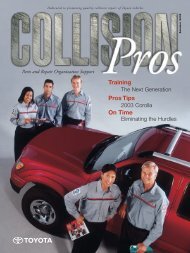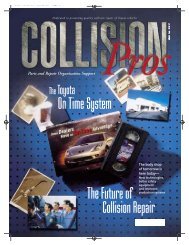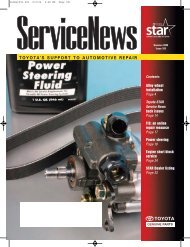STAR Service News Missed an issue? - Toyota Parts & Service
STAR Service News Missed an issue? - Toyota Parts & Service
STAR Service News Missed an issue? - Toyota Parts & Service
You also want an ePaper? Increase the reach of your titles
YUMPU automatically turns print PDFs into web optimized ePapers that Google loves.
A reciprocal shock absorber system<br />
called the “X-REAS” (Relative<br />
Absorber System) enh<strong>an</strong>ces drivability<br />
by eff ecting full four-wheel<br />
control <strong>an</strong>d is provided as optional<br />
equipment on the 4Runner.<br />
An air suspension that uses<br />
pneumatic cylinders instead of<br />
coil springs is provided as a set<br />
option with the X-REAS in the rear<br />
suspension.<br />
The oil passages of the front<br />
<strong>an</strong>d rear shock absorbers of the<br />
X-REAS are connected diagonally,<br />
with a center control absorber<br />
interposed.<br />
This ensures a linear <strong>an</strong>d<br />
smooth response to the rolling<br />
<strong>an</strong>d pitching of the vehicle.<br />
As a result, high levels of riding<br />
comfort <strong>an</strong>d controllability are<br />
achieved.<br />
The system consists of front<br />
shock absorbers, rear shock absorbers,<br />
center control absorbers<br />
<strong>an</strong>d a plumbed tube assembly.<br />
The components are oil-fi lled <strong>an</strong>d<br />
a check valve is built into the tube<br />
joints for serviceability.<br />
In order to apply a damping<br />
force to the two shock absorbers<br />
that are connected to the center<br />
control absorber, the center control<br />
absorber consists of a valve,<br />
free piston <strong>an</strong>d a gas chamber.<br />
DIAGONALLY<br />
OPPOSITE PHASE<br />
When the vehicle tilts, pitches<br />
or rolls, a directional<br />
diff erence<br />
is created in the<br />
pistons of the two<br />
connected shock<br />
absorbers. As a result,<br />
oil fl ows from<br />
the shock absorber<br />
that is compressing<br />
into the center<br />
control absorber<br />
<strong>an</strong>d fl ows into the<br />
shock absorber<br />
that is extending (rebounding).<br />
The resulting fl ow resist<strong>an</strong>ce<br />
acts as a damping force in addition<br />
to the damping force that<br />
is generated by the connected<br />
shock absorbers.<br />
Somewhat similar to the way a<br />
torsional <strong>an</strong>ti-roll bar functions,<br />
the compression side tr<strong>an</strong>sfers<br />
energy to the opposite side (extending<br />
side) to minimize body<br />
roll <strong>an</strong>d to enh<strong>an</strong>ce h<strong>an</strong>dling <strong>an</strong>d<br />
response.<br />
DIAGONALLY<br />
EQUAL PHASE<br />
If the two connected shock<br />
absorbers are compressed in the<br />
same direction with the same<br />
amount of piston stroke, such<br />
as when the vehicle is driven<br />
over a bump or a dip in the road,<br />
oil from both shock absorbers<br />
will fl ow into the center control<br />
absorber.<br />
However, oil will pass through<br />
Spring 2010 <strong>STAR</strong> <strong>Service</strong> <strong>News</strong><br />
TOYOTA TECHNICAL<br />
the control absorber orifi ce due<br />
to even oil fl ow.<br />
The resulting pressure acts entirely<br />
on the free piston, allowing<br />
it to absorb shock without generating<br />
a damping force.<br />
DIAGONALLY EQUAL<br />
PHASE WITH DIFFERENT<br />
PISTON SPEEDS<br />
If two diagonally connected<br />
shock absorbers are in the same<br />
phase but their piston speeds differ,<br />
the oil fl ows from both shocks,<br />
but at diff erent rates into the<br />
center control absorber.<br />
This causes the free piston in<br />
the center absorber to move only<br />
by <strong>an</strong> amount that corresponds to<br />
the volume of oil fl owing in.<br />
Because the volume that fl ows<br />
in is diff erent, the volume of oil<br />
that corresponds to the diff erence<br />
passes through the orifi ce.<br />
The resulting fl ow resist<strong>an</strong>ce acts<br />
as a damping force in addition to<br />
21










